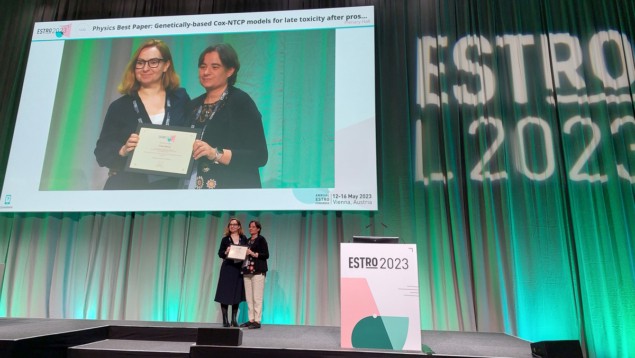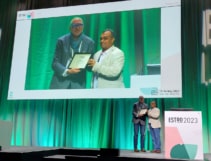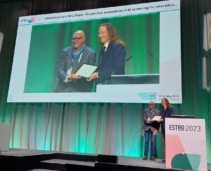
ESTRO 2023, the annual congress of the European Society for Radiotherapy and Oncology, featured an extensive scientific programme spanning six key themes: physics, brachytherapy, clinical, interdisciplinary, radiobiology and RTT (radiation therapists). For each of these tracks, one submitted abstract was chosen as the “Best Paper” in its class, with the winners presenting their research in a dedicated “Highlights of Proffered Papers” plenary session.
Toxicity modelling
In the physics track, the Best Paper Award went to Tiziana Rancati from the National Cancer Institute of Milan, for a study examining models of late toxicity after prostate cancer radiotherapy. In particular, Rancati introduced a model for normal tissue complication probability (NTCP) based on Cox regression (a method for predicting the time to an event using several variables): the Cox-NTCP model.
“The specific purpose of this analysis was to propose a Cox-NTCP model for late toxicity after prostate cancer radiotherapy, including genetic information from a polygenic risk score incorporating SNP–SNP interactions,” Rancati explained. To develop their model, Rancati and colleagues worked within the REQUITE and RADPrecise projects, multi-centre studies of cancer patients that aimed to validate predictive models and biomarkers to reduce radiotherapy side effects.
Their analysis considered four late-toxicity endpoints: grade 1+ and 2+ rectal bleeding; grade 2+ late urinary frequency; and grade 1+ late haematuria (blood in the urine). For dosimetry, they investigated equivalent uniform dose (EUD) values calculated from dose–volume histograms (DVHs) and dose–surface histograms (DSHs).
Using the two-year REQUITE follow-up data, Rancati and colleagues developed an interaction-aware polygenic risk score. They started with 43 SNPs (single nucleotide polymorphisms, the most common type of genetic variation among people) known to be associated with late toxicity, validated 13 that worked within REQUITE, and used data mining to find SNP–SNP combinations associated with either increased or decreased risk of toxicity. They then weighted the risk score and protective risk score to create a polygenic risk score with interactions (PRSi).
The analysis included 1482 patients, the majority of whom received volumetric modulated arc therapy (VMAT) with conventional fractionation. Patient follow-up occurred at between one and eight years, with a median follow-up of two years. “With such heterogeneity in follow-up, we shifted from static NTCP models to actuarial NTCP models based on Cox regression,” Rancati explained. “This takes into account the maximum follow-up time of each patient and the time of any toxicity.”
Rancati shared some results from the study. For grade 2+ urinary frequency, for example, the EUD to the whole bladder (calculated from the DSH) was the best dosimetric predictor of long-term toxicity. Cox-NTCP curves of toxicity versus bladder-surface EUD showed that toxicity was most likely for radiosensitive patients with PRSi scores of 1, and lowest for those with scores of -1, as seen in radioresistant patients. She noted that the curves were different for three- and five-year follow-up, emphasizing the importance of including time into NTCP models, while the PRSi scores show the importance of the genetic risk factors.
Results for haematuria were similar, but with EUD to the bladder neck appearing more important than dose to the whole bladder. For rectal bleeding, the best dosimetric descriptor was rectal EUD calculated from the DVH. Rancati noted that in this case, the PRSi score was still associated but less discriminative than seen with other toxicities, with a shallower dose–response curve.
“We showed the benefit of adding a polygenic risk score with interactions to Cox-NTCP prediction models,” Rancati concluded. “These models allow both patient-specific tailoring of the prediction and accounting for the follow-up time. Dose to organs- or sub-organs-at-risk modulates the risk of toxicity.”
Improving quality-of-life
The Best Paper Award in the brachytherapy track went to Vivek Anand from the Hinduja Hospital and Medical Research Centre in Mumbai, India. Anand presented a study comparing quality-of-life for patients with tongue cancer after treatment with external-beam radiotherapy (EBRT), or EBRT plus high-dose rate (HDR) brachytherapy.

Anand explained that adjuvant radiotherapy for treatment of tongue cancers is known to reduce the patient’s quality-of-life. HDR brachytherapy, however, can deliver a high dose of radiation to the tumour while sparing adjacent normal tissues. “This modality reduces morbidity without compromising on outcomes,” he said.
The study included 63 oral tongue cancer patients who had undergone surgery followed by adjuvant radiotherapy, using either using EBRT or EBRT plus brachytherapy. EBRT was delivered to the neck nodes and whole tongue, with a higher dose boost delivered to the tumour bed and positive nodes. In the second group, patients received EBRT to the neck nodes, with a higher dose to positive nodes, plus six days of HDR brachytherapy to the primary tumour bed. Patients with cancerous nodes also had weekly concurrent chemotherapy.
To compare functional outcomes in the two groups, the researchers used a questionnaire – the EORTC Quality of Life Head and Neck Module – which asks patients to rate dozens of factors including, for example, pain in the mouth and jaw, problems swallowing, loose teeth, speech problems, dry mouth, skin problems, and weight loss or gain. They also examined overall survival in both groups.
The researchers found that the overall treatment time was slightly increased in the EBRT plus brachytherapy group, from 43.6 to 51.1 days. However, there was no difference in overall survival between the two groups.
Of the 63 patients, 24 in EBRT group and 18 in the EBRT plus brachytherapy group completed the questionnaire, at median follow-ups of 37 and 35 months, respectively. “All symptom scales showed that brachytherapy was better,” said Anand. “Clinically and symptomatically, they were worse in the EBRT group. The only statistically significant parameter was weight loss, which proves that brachytherapy had little problems when used for the oral cavity.”
Anand concluded that delivering radiation dose by brachytherapy to the oral tongue improves the patient’s quality-of-life, noting that the increased treatment time in the EBRT plus brachytherapy group did not result in decreased outcomes. “Larger numbers of patients and longer follow-up are warranted to study if we can make this one of the standard-of-care treatments,” he said.
Screening for lung disease
Andrew Hope from Princess Margaret Cancer Centre and the University of Toronto was the winner of the Best Paper Award in the interdisciplinary track, for his study on AI-based screening for interstitial lung disease (ILD). ILD poses a big challenge for oncology, Hope explained. It predisposes patients to lung cancer, but also increases the risks of cancer treatment. For radiotherapy, ILD increases the risk of radiation pneumonitis and even death.

ILD is traditionally diagnosed before radiation treatment using the patient’s diagnostic imaging scans or by noting clinical symptoms such as shortness of breath. But in some cases, patients may progress onto radiotherapy with undetected ILD, increasing the risk of radiation-related complications.
“However, there is an additional image that is available – the treatment planning image,” said Hope. “Routinely, this is not diagnostically reviewed or assessed. So we thought that there might be an opportunity to explore this image in a more diagnostic fashion.”
To automatically identify patients with ILD during radiotherapy planning, Hope and colleagues developed a machine learning pipeline called the MIRA clinical learning environment (MIRACLE). The MIRACLE-ILD system uses convolutional neural networks (CNNs) to identify ILD from a planning image, including a 2D U-net to perform the lung contouring and a 3D CNN for classification.
Following initial training of the MIRACLE-ILD on diagnostic CTs (which did not work well due to differences between diagnostic and planning scans), the researchers retrained the model using transfer learning with a radiotherapy-specific data set. They chose to threshold the model to provide 65–75% sensitivity to ILD at the cost of a 15–20% false positive rate.
To verify the clinical performance of MIRACLE-ILD, the team first deployed the model in “silent mode”, with no notifications sent to treating physicians. This study included 180 patients, nine of whom had ILD. MIRACLE-ILD correctly identified six of these cases, with a reasonable accuracy (86%), sensitivity (67%) and specificity (87%). “MIRACLE would have detected two of the four patients that were unknown to have ILD by the treating team at the time,” Hope noted.
In May 2022, the team moved on to the live phase, in which any positive cases were flagged to the physicians. This study included 254 patients, 13 of whom had ILD, and used the same model and threshold as before. MIRACLE-ILD flagged 42 patients as ILD-positive, with good accuracy (84%) and specificity (85%), but slightly lower sensitivity (54%) than previously. Here, there were seven unknown ILD cases and the system found three of them prior to treatment.
“In total, we had 434 patients of which 22 had ILD. The overall performance of the model was quite reasonable, with an accuracy of 85% and a specificity of 86%. We detected five of 11 unknown ILD cases in this cohort,” said Hope. “We feel this represents a validated prospective way to screen radiotherapy plans for the possibility of a patient having ILD.”
He pointed out that the system remains live at the Princess Margaret Cancer Centre and is used to screen every patient who receives thoracic radiotherapy.
The rest of the best
Clinical Best Paper: Molecular classification of endometrial cancer is predictive of response to adjuvant radiotherapy – Nanda Horeweg, Leiden University Medical Center
Radiobiology Best Paper: Hypoxic tumour cells drive tumour relapse after radiotherapy as revealed by a novel tracing tool – Apostolos Menegakis, Netherlands Cancer Institute
RTT Best Paper: Randomized trial of person-centered versus standard RTT care for breast cancer patients NCT04507568 – Michael Velec, Princess Margaret Cancer Centre
- SEO Powered Content & PR Distribution. Get Amplified Today.
- PlatoAiStream. Web3 Data Intelligence. Knowledge Amplified. Access Here.
- Minting the Future w Adryenn Ashley. Access Here.
- Buy and Sell Shares in PRE-IPO Companies with PREIPO®. Access Here.
- Source: https://physicsworld.com/a/award-winning-studies-focus-on-reducing-radiotherapy-risks/



